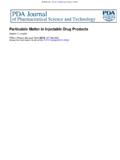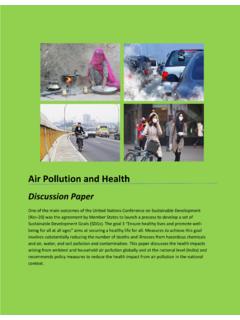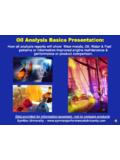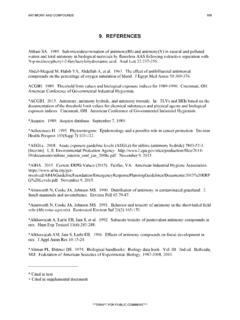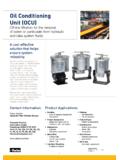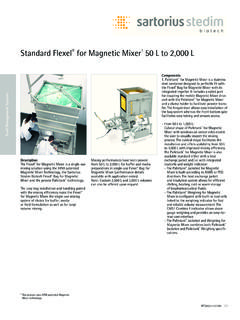Transcription of EACO Mould Abatement Guidelines Edition 3 (2015)
1 eaco Mould Abatement Guidelines Edition 3 (2015). Foreword This guideline has been prepared to assist building owners, constructors, contractors, subcontractors and workers who have duties under the Occupational Health and Safety Act and its Regulations to safely perform work activities involving Mould (Microbial) Abatement and remediation. The guideline is intended to promote safe work practices, the use of personal protective equipment, worker awareness and training and is based in a thorough review of the available guidance materials available to December 2014. and professional experience of the Abatement industry in Ontario. We believe that this guideline will not only help employers fulfill their responsibilities and due diligence under the Occupational Health and Safety Act but will also assist them to better address the challenges involved with proper assessment and remediation of Mould (Microbial) contamination in buildings.
2 Disclaimer eaco disclaims any liability or risk resulting from the use of the work practices and recommendations discussed in the guideline. It is the user's responsibility to ensure that work practices and recommendations discussed in the guideline apply to specific workplaces and projects and to ensure compliance with all other applicable federal, provincial and local acts, codes and regulations. 1 of 24. eaco Mould Abatement Guidelines Edition 3 (2015). Table of Contents _____. 1 SECTION A: GENERAL POINTS AND LIMITATIONS .. Page 3. 2 SECTION B: GENERAL PRECAUTIONS APPLICABLE. TO ALL LEVELS OF Mould Abatement WORK .. Page 4. 3 SECTION C: PRECAUTIONS FOR LEVEL 1, 2 AND. 3 Mould Abatement Page 7.
3 APPENDIX A: TYPICAL LEVEL 3 Mould DECONTAMINATION. FACILITY LAY-OUT .. Page 12. APPENDIX B: PROCEDURES FOR CLEAN-UP OF BIRD AND. BAT DROPPINGS Page 13. APPENDIX C: ADDITIONAL HAZARDS WITH ABRASIVE BLASTING. IN Mould Abatement . Page 17. APPENDIX D: ADDITIONAL PROCEDURES FOR UNSANITARY. WATER REMEDIATION .. Page 19. APPENDIX E: DEFINITIONS . Page 21. 2 of 24. eaco Mould Abatement Guidelines Edition 3 (2015). SECTION A: GENERAL POINTS AND LIMITATIONS. 1. Three levels of work practice are given for removal of Small, Medium and Large-scale Mould growth, depending on the extent of material supporting Mould growth present. The thresholds between Small and Medium project areas (10 ft2) and between Medium and Large project areas (100 ft2) are a guideline only and are subject to professional judgment.
4 eaco recommends that the enumeration of Mould growth be based on an approximation of the extent of visible growth (total affected area of building material), including the estimated extent of any hidden Mould . 2. These procedures do not address the identification or control of the cause(s) of the Mould growth being abated by these procedures. This would include such factors as past flooding, moisture intrusion and elevated levels of relative humidity. The project authority is cautioned to ensure that the underlying cause(s) of the Mould growth is investigated and remedied prior to completing the Abatement process to reduce the potential for Mould re-growth. 3. These procedures do not address the potential for fungal infections that may be acquired by Susceptible Occupants in hospitals or other health care settings if Mouldy materials are disturbed without appropriate precautions.
5 Refer to Construction-related Nosocomial Infections in Patients in Health Care Facilities Decreasing the Risk of Aspergillus, Legionella and Other Infections , July 2001, Canada Communicable Disease Report, Health Canada and CSA Standard , Infection Control During Construction or Renovation of Health Care Facilities. 4. These procedures do not address the potential presence of Designated Substances (asbestos, lead, etc.). or other hazardous materials in a Mould remediation work area. The project authority is cautioned that designated substances are regulated in Ontario under the Occupational Health & Safety Act. In addition, Ontario Regulation 278/05, Regulation Respecting Asbestos on Construction Projects and in Buildings and Repair Operations (O.)
6 Reg. 278/05) outlines specific procedures for the handling and disturbance of asbestos-containing materials (ACM). Typical ACMs that may be disturbed as part of a Mould remediation project include drywall joint filling compound, ceiling tiles, pipe and duct insulation and vinyl flooring. 5. These procedures are not directly intended to address Biohazards, other than Mould , potentially present in a project area as a result of contamination with sewage waste, river floods or other water with high levels of Microbial contamination. Appendix D does provide additional procedures for unsanitary remediation. The reader is referred to the guidance of the Institute of Inspection, Cleaning and Restoration Certification S500 Standard, Standard and Reference Guide for Professional Water Damage Restoration.
7 Additional precautions might apply. 6. These Guidelines are not meant to respond to the development of minor areas of superficial Mould growth in households due to water absorption or condensation on the occupied side of finishes, often referred to as lifestyle Mould growth. Examples include spotty Mould growth on grout in bathrooms or on cold window frames under winter conditions. Such areas of minor surface Mould growth are generally limited in area and can usually be addressed with improved ventilation and/or moisture control, and standard house cleaning methods. However, if there are large areas of surface condensation or indications of sub-surface moisture sources, the area should be inspected for the possibility of hidden water damage or Mould growth.
8 3 of 24. eaco Mould Abatement Guidelines Edition 3 (2015). SECTION B: GENERAL PRECAUTIONS APPLICABLE TO ALL LEVELS OF. Mould Abatement WORK. 1. Protection of Occupants The project authority should consider whether occupants should be removed from areas adjacent to the work area. The removal of occupants from spaces adjacent to the work area is not necessary in all cases but should be considered in the presence of Susceptible Occupants including but not limited to infants less than 12 months old, persons having undergone recent surgery, the elderly, immune suppressed people, or people with chronic inflammatory lung diseases. 2. Worker Training and Medical Pre-screening Mould Abatement workers shall be trained in the hazards of Mould Abatement and in the procedures to be followed.
9 Training at a minimum shall include classroom and site instruction. Minimum training topics shall include: hazards of Mould Abatement ; use and limitations of personal protective equipment such as respirators and gloves; proper Abatement practices including site isolation, removal techniques, proper clean-up and decontamination procedures. General health and safety training should also be provided to workers, as required by the Occupational Health & Safety Act and regulations for construction sites, and waste handling and disposal regulations. Workers must be fit to work with potential Mould or microbial exposure. Workers with a history of significant allergic disease (asthma, hay fever, hives, etc.)
10 Or with a potential immuno-compromised status (persons with an immune system disease, taking immune system suppression medication, etc.) should consult with an experienced physician to determine whether Mould removal activities, and the associated potential for exposure to pathogenic materials, would present an unacceptable health risk. Mould Abatement workers who may encounter a risk of infectious disease from unsanitary water sources (sewage, river floods, etc.) should consult with an experienced physician regarding vaccinations to reduce the risk of infectious disease through available immunizations, particularly Hepatitis A and B, tetanus and polio. 3. Respiratory Protection The respiratory protection in these procedures has been established for protection against fungal particulate material, for which a Respirator with a NIOSH-approved particulate filter will be adequate.




